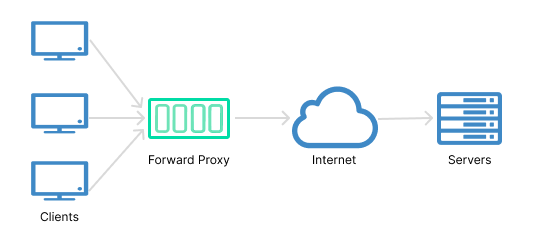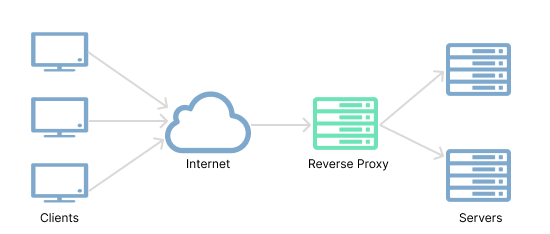Forward Proxy vs Reverse Proxy: A Comprehensive Guide


A proxy acts as an intermediary between the client and server, playing a crucial role in facilitating communication . It is widely used across various industries. In this article, you’ll learn about the functions, differences, and appropriate use cases for Forward Proxy and Reverse Proxy. It will help you choose the right product and service based on your needs.
What is Forward Proxy?
Forward Proxy
A forward proxy is a server located between the client (e.g., the user’s device or browser) and the target server (e.g., a website). When the client requests access to a website or resource, the request is first sent to the proxy, which then forwards the request to the target server on behalf of the client.
There are many types of forward proxies, including anonymous proxies, transparent proxies, HTTP proxies, SOCKS5 proxies, and other types of proxies.
The primary functions of a forward proxy focus on privacy protection, access control, content filtering, and performance optimization.
Here are some key functions of a forward proxy:
Privacy Protection and Anonymity
A forward proxy can hide the user’s real IP address, so the target server only sees the proxy server’s IP address. This helps enhance user privacy and anonymity and prevents personal information from being exposed. For example,by using a forward proxy, users can avoid being tracked or having their real IP address logged.
Accessing the internet via a proxy server hides the user’s online behavior.
Unlocking Restricted Resources
A forward proxy can help users access restricted resources. Some websites or online services restrict access based on the user’s geographical location or IP address. By using a server located in a different country or region, a forward proxy can bypass these restrictions, allowing users to access the desired content.
Caching and Bandwidth Savings
A forward proxy can cache frequently accessed resources, reducing repeat requests, improving user access speed, and saving bandwidth.
When the proxy server detects that the client has requested cached content, it can directly serve the cached resource instead of requesting it from the target server, thereby speeding up access.
By caching frequently accessed data, the forward proxy reduces the amount of communication with the target server, saving bandwidth.
What is Reverse Proxy?
Reverse Proxy
A reverse proxy server’s primary function is to receive and handle external requests on behalf of one or more backend servers. It then forwards the requests to the internal servers for processing. In this way, clients only know the address of the reverse proxy server and cannot access the real IP addresses and information of the backend servers, thereby improving security and scalability.
Key functions of a reverse proxy:
Load Balancing
A reverse proxy can distribute incoming traffic across multiple servers to ensure that no single server is overwhelmed by requests. This helps improve the performance and scalability of websites and web applications.
Security
By hiding the identity and structure of the backend servers, a reverse proxy can effectively prevent these servers from being directly exposed to the internet, reducing the risk of DDoS (Distributed Denial of Service) attacks. Additionally, the reverse proxy can handle SSL encryption (SSL termination), offloading SSL-related encryption and decryption tasks from the backend servers, thereby relieving their burden.
Caching
A reverse proxy can cache content, reducing the load on backend servers. By responding to repeat requests directly from the cache, it improves system performance and reduces latency for end users.
Compression and Optimization
A reverse proxy can compress incoming and outgoing data, optimizing bandwidth and reducing content loading times. It can also perform various optimization tasks, such as compressing scripts and images.
Differences between Forward and Reverse Proxies
| Feature | Forward Proxy | Reverse Proxy |
| How it works | Client accesses the target server through the proxy server | Client accesses the reverse proxy, which forwards requests to the backend server |
| Traffic direction | Request from the client to the proxy server, then to the target server | Request from the client to the reverse proxy, then forwarded to the backend server |
| Use cases | Accessing restricted resources, anonymous browsing, data security | Load balancing, enhancing security |
| Client configuration | Proxy server needs to be configured in the browser or client application | No client configuration required; reverse proxy is configured and managed by the server administrator |
What Services Does Thordata Offer?
Thordata, as a forward proxy, can help you achieve anonymous browsing, protect your personal privacy, and support global resource access. By choosing Thordata, you can immediately benefit from the following advantages:
Rich IP Resources
Thordata provides a wide range of proxy types to meet your global access needs:
Residential Proxies: Covering 195+ countries/regions with 60M+ compliant ethical IPs.
ISP Proxies: Covering 30+ countries/regions with 550k+ compliant ethical IPs.
Data Center Proxies: Covering 20+ countries/regions with 650k+ compliant ethical IPs.
Unlimited Proxies: Covering 60+ countries/regions with 47.7M+ compliant ethical IPs.
Free Location Services
Purchasing Thordata’s Residential Proxy or Unlimited Proxy plans includes free location services (country, state, city, ASN) to enable precise targeting at low cost.
High-Quality Proxy Services
Thordata’s IP quality is high, with proxy response times of under 0.5 seconds and a 99.9% connection success rate. This improves your work efficiency and provides a better user experience. Additionally, Thordata offers 24/7 customer support. For assistance, contact us at support@thordata.com.
Conclusion
Forward proxies serve as intermediaries between clients and servers, helping control, monitor, and protect user access to the internet, typically used for content filtering, privacy enhancement, and caching. Reverse proxies, as intermediaries that forward client requests to backend servers, offer benefits such as load balancing, enhanced security, caching, and SSL termination. They are widely used to improve web applications and website performance.
Frequently asked questions
Why would you use a reverse proxy?
Businesses often use reverse proxies to distribute incoming traffic across multiple backend servers. This helps balance the load, ensuring no single server is overwhelmed by requests, thereby improving overall system performance and reliability.
What are the disadvantages of reverse proxies?
The deployment and configuration of reverse proxies are relatively complex and require specialized knowledge. Once configured, reverse proxies may have some impact on network performance and response time. Since all internal website traffic goes through the reverse proxy, if the reverse proxy fails, it can affect access to the backend servers.
Is an API gateway a reverse proxy?
API Gateways are specialized servers used for managing and forwarding API requests, acting as an intermediary layer between frontend and backend API services. A reverse proxy is a server that handles client requests on behalf of backend servers. An API Gateway can be considered a special form of reverse proxy, extending the functionality of a reverse proxy. While a reverse proxy forwards requests, an API Gateway offers additional features such as load balancing, unified authentication, circuit breaking, and more.
About the author
Clara is a passionate content manager with a strong interest and enthusiasm for information technology and the internet industry. She approaches her work with optimism and positivity, excelling at transforming complex technical concepts into clear, engaging, and accessible articles that help more people understand how technology is shaping the world.
The thordata Blog offers all its content in its original form and solely for informational intent. We do not offer any guarantees regarding the information found on the thordata Blog or any external sites that it may direct you to. It is essential that you seek legal counsel and thoroughly examine the specific terms of service of any website before engaging in any scraping endeavors, or obtain a scraping permit if required.